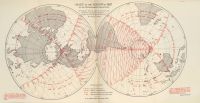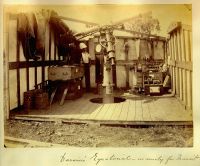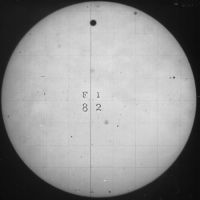|
Written on Venus's transit of 1882 Preparation of the transit observations of 1882 French missions observations of 1882 English missions observations of 1882 American missions observations of 1882 Other missions observations of 1882 In spite of the amazing new technologies available by 1874 (in particular the photography and the electrical telegraph), the Venus transit method does not seem to allow a precise determination of the solar parallax as expected before. Therefore, the 1882 transit moderately motivated the astronomers worldwide. Preparation of the transit observations of 1882Wolf 1882, conference [[1401-15-(001à023) ]] Charles Wolf (1827-1918), astronomer at the Paris Observatory, presents a good summary of the results obtained during the previous transits, in particular the 1874 one. He gives some information about the 1882 transit preparation. [1401 (15)] Wolf, C., Conférence sur les passages de Vénus devant le Soleil (Conference on Venus transits in front of the Sun), given at the « Société d’encouragement pour l’industrie nationale », on May 20, 1882, Paris, 1882, in 4. French text (23 p). Proctor 1873, MNRAS-33 (1873) p.470-472 [[ MNRAS-33 p.470-472]] Richard Anthony Proctor (1837-1888) published a 1882 transit map in polar view, as done for the 1874 transit. Proctor provided a selection of several texts published in MNRAS from 1869 to 1873. The color map (plate xxi) is about the 1882 transit. [20362] Proctor Richard A., Studies of Venus transits. An investigation of the 1874 and 1882 Venus transits circumstances, London, 1882. English text, (170 p). 1882 American missions [[3003-21-(001à054) ]] General instructions to get ready for the observations: observing sites choice, instruments and cameras, the encouraged use of the electrical telegraph for time and longitude determination (p. 37). We recommend, at the end, the nice prediction maps. [3003(21)] Instructions for observing the transit of Venus, December 6, 1882, prepared by the Commission authorized by Congress, and printed for the use of the observing parties by authority of the Hon. Secretary of the Navy, Washington, Government Printing Office, 1882. English text, (55 p). French missions observations of 1882Dumas 1882, CRhAS-95 (1882) p. 575-578 [[ CRhAS-95 p.575-578 ]] Jean-Baptiste Dumas (1800-1884), Science Academy secretary and president of the 1882 Venus transit committee, presents the 8 French missions that has been to America: Florida, Mexico, Antilles (Haiti, Martinique), Chile and Argentina (Santa-Cruz, Chubut, Rio-Negro). Félix Tisserand (1845-1896) already observed the 1874 passage in Yokohama, with Janssen. Félix Arago (born in 1849), nephew of François Arago (1786-1853), participated to the Mexico mission. Perrotin, portrait [[ Perrotin ]] Henri Perrotin (1845-1904), director of the Nice Observatory in 1880, supervised the Rio-Negro mission in Patagonia (Argentina). Various authors, CRhAS-95 (1882) p. 1182-1342 [[ CRhAS-95 p.1182-1342 ]] This selection encompasses numerous observing notes: Argentina (p. 1182), Fort-de-France (p. 1184), Marseille (p. 1185), Chateaudun (p. 1208), Roma (p. 1209 et 1269), Alger (p. 1267), Toulon (p. 1309), Nice (p. 1339), Spain (p. 1341). The French missions telegrams are available p. 1206 and p. 1267. Various authors, CRhAS-96 (1883) p. 227-1292 [[ CRhAS-96 p.227-1292 ]] Second part of the previous selection: Argentina (p. 227), Algeria, with a spectral analysis of the Venus atmosphere by Janssen (p. 288), California (p. 476), southern Chile, at Punta-Arenas (p. 1013), were some weather improvements allowed to observe the contacts; it is interesting to note the light thread observed during the contact (instants are given in local mean time), at the Antilles (p. 1291), where the entry was hidden by clouds. Various authors, CRhAS-97 (1883) p. 353-443 [[ CRhAS-97 p.353-443 ]] This volume contains the reports on the 1882 transit. It describes in details the French missions (the table of contents can be found page 443) [[ CRhAS-97 p.443 ]]. Longitudes are given with respect to the Paris meridian; instants are in local mean time. Bouquet de la Grye 1887, CRhAS-104 (1887) p. 550-551 [[ CRhAS-104 p.550-551 ]] More than 1000 photographic plates of the 1882 transit, realized by the French missions, are available for micrometric measurements of the Venus positions on the Sun. English missions observations of 18821882 English missions[[1402-19-(001à088) ]] Report (88 p) on the numerous English missions in 1882: Indian Ocean, South Africa, Strait of Magellan, Jamaica, Bermudas, Cambridge (Mass.), Canada, New Zealand, Australia. The comparison of different measurements lead to a solar parallax value comprised between 8.82" and 8.88". [1402(19)] Transit of Venus, 1882. Report of the Committee appointed by the British Government to superintend the arrangements to be made for the sending of expeditions at the Government expense, and securing cooperation with the Government expeditions for the observation of the transit of Venus, 1882, December 6. English text, (88 p). Darwin in Brisbane (Australia), group picture [[ 1882 Brisbane Hume373 ]] Leonard Darwin (son of Charles Darwin, 1809-1882), William Morris and Peak went to observe in Jimbour, near Brisbane, west coast of Australia. Darwin’s
equatorial lens telescope The equatorial lens telescope is set and ready for the observations of the Venus transit coming out; unfortunately, clouds hid the Sun during the whole December 7th morning ! American missions observations of 1882This is one of the numerous dry collodion photographic plates showing the Venus spot on the Sun’s disc. The image was taken through a telescope and is therefore upside-down (the North direction is to the bottom). The Venus spot moves here from right to left. Some plates defects as well as real solar spots are visible. Obs. Wellington, photo [[ Observatoire de Wellington ]] The American Mission, directed by Simon Newcomb (1835-1908), observed in Wellington, 60 km North-East Cape of Good Hope. Abbie Park Ferguson, photo [[ Abbie Park Ferguson ]] This is the portrait of Abbie Park Ferguson (1837-1919) who directed the "Huguenot Seminary for girls" in Wellington, South Africa. The American mission directed by Simon Newcomb, settled down in the school garden. Miss Ferguson actively participated to the astronomers’ measurements. Mary Elizabeth Cummings, photo [[ Mary E. Cummings ]] Mary Elizabeth Cummings (1854-1947), teacher at the Wellington seminary, participated to the observations, as well as her colleagues Abbie Ferguson and J.N. Brown, in collaboration with the astronomers from the American mission. Other missions observations in 1882Report from the German missions, containing observations driven by Müller and Deichmüller at Hartford (Connecticut), by Franz and Kobold at Aiken (South Carolina), by Hartwig and Peter at Bahia Blanca (Argentina), by Auwers (1838-1915) and Kustner at Punta Arenas (Southern Chile), and by Schrader and Vogel at Moltke Hafen (South Georgia island), along with comparisons with German missions observations from 1874.
[21665(14)] Lefebvre (Father). Les passages de Vénus sur le disque solaire, étude historique (Historical study of the Venus transits on the Sun’s disc) followed by an appendix about the December 6, 1882 observations and the Belgian expeditions, 1883. French text (70 p) Pechüle, danish expedition [[21675-6-(001à045) ]] The Danish Carl Frederick Pechüle supervised a mission in Saint-Croix Island in the Antilles (100 km south east of Porto-Rico). The cloudy weather corrupted the precise observations. Pages 25 to 45 deal with spectroscopic observations of stars, performed one month after the Venus transit. 1882 observations analysisHarkness, portrait [[ Harkness figure 7.4 ]] William Harkness (1837-1903) observed in Tasmania in 1874, where the weather remained cloudy. As a horizontal photoheliograph specialist [[MNRAS-37, 1877, p. 93]], he was in charge of the photographic plates measurements analysis of the 1874 and 1882 American missions. Harkness 1888, Astron. Journ.-8 (1888), p. 108 [[ Astron.Journ.-8 p.108 ]] The 1475 American photographs of the 1882 transit lead to a solar parallax value of 8.847" +/- 0.012" (0.14 % precision). Bouquet de la Grye 1899, CRhAS-129 (1899) p. 986-993 [[ CRhAS-129 p.986-993 ]] Jean-Jacques BOUQUET de la GRYE (1827-1909) presents the summary of the 1882 French missions observations, with corrected measurements. Longitudes (p. 988) are still given with respect to the Paris meridian, although it has been decided during the International Conference in Washington (1884) that the Greenwich meridian should be the reference. The solar parallax value found is 8.80" +/- 0.01" (with a 0.11 % precision). This result confirms the value claimed during the International conference for fundamental stars that took place in Paris in 1896. This parallax corresponds to a distance of 149.5 +/- 0.2 millions kilometres.
|


